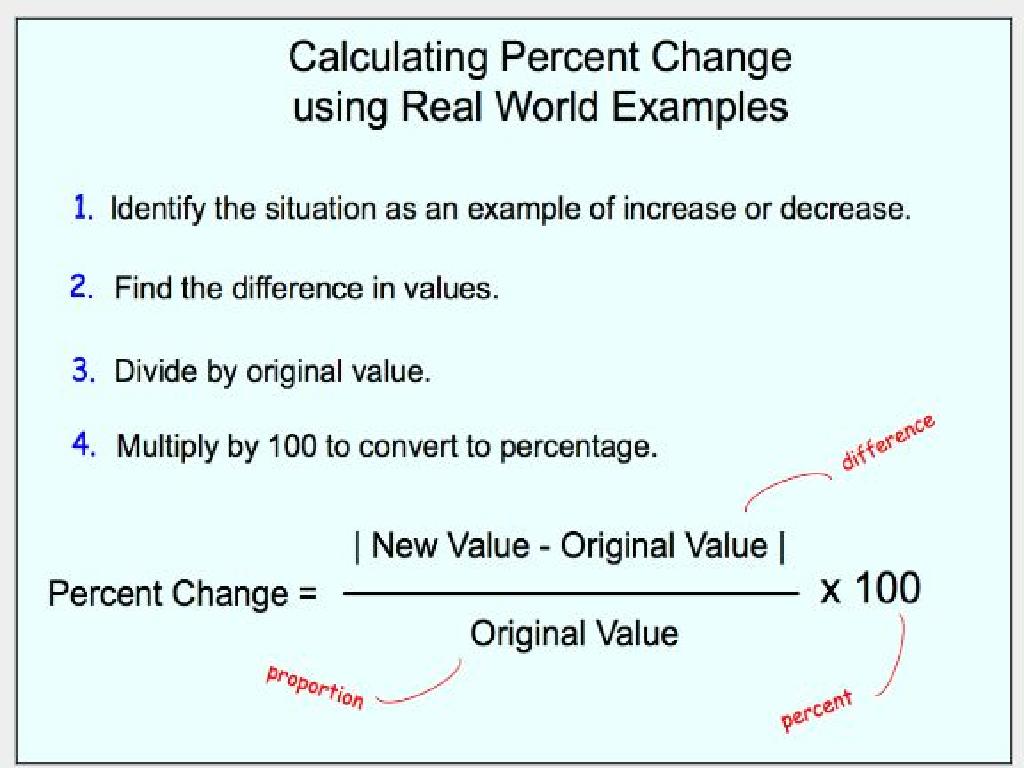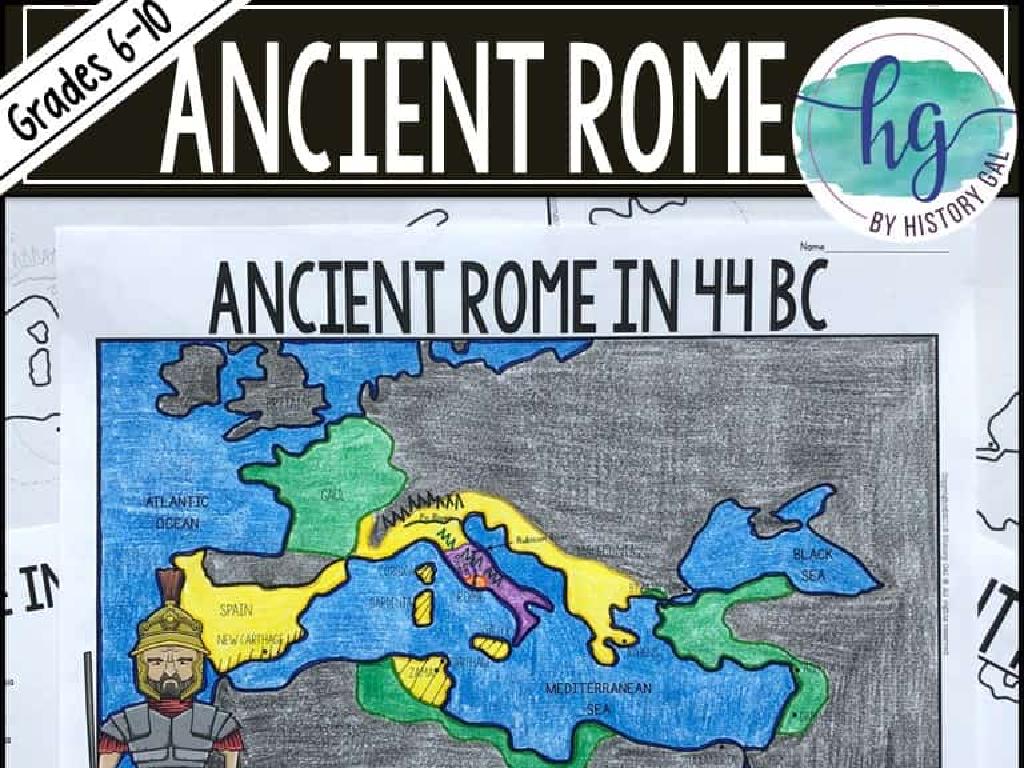Early Roman Society And Politics
Subject: Social studies
Grade: Sixth grade
Topic: Rome And The Byzantine Empire
Please LOG IN to download the presentation. Access is available to registered users only.
View More Content
Welcome to Ancient Rome!
– Rome: Republic to Empire
– Rome began as a Republic and evolved into a powerful Empire.
– Timeline of Roman history
– Key events from the founding of Rome to the fall of the Byzantine Empire.
– Rome’s impact on the world
– Rome’s legal, political, and cultural contributions have lasting effects.
– Governance and society
– Understanding the structure of Roman government and social hierarchy.
|
This slide introduces students to the grandeur of Ancient Rome and its transition from a Republic to an Empire. Highlight the timeline of Roman history, emphasizing key events such as the founding of Rome, the rise of the Roman Republic, the transition to an Empire, and the eventual fall of the Byzantine Empire. Discuss Rome’s significant contributions to modern legal systems, governance, architecture, language, and culture. Explain the structure of Roman society, including the Senate, the Consuls, and the role of the citizens. This overview sets the stage for a deeper dive into the intricacies of Roman political and social systems and their enduring influence on the world.
The Birth of Roman Society
– Myth of Romulus and Remus
– Twin brothers raised by a wolf, founders of Rome.
– From Kingdom to Republic
– Rome evolved from monarchy to a republic.
– Patricians vs. Plebeians
– Patricians: aristocratic, Plebeians: common citizens.
– Social dynamics in Rome
|
This slide introduces students to the foundational aspects of early Roman society and its political evolution. Begin with the legendary tale of Romulus and Remus, which sets the stage for Rome’s cultural heritage. Discuss the transition from the Roman Kingdom to the Republic, highlighting how this change allowed for more democratic elements in Roman governance. Explain the social hierarchy, with Patricians being the elite class and Plebeians as the commoners, and how this division affected political rights and power. Emphasize the importance of understanding these social dynamics to grasp how they influenced the development of Roman political institutions and laws. Engage students by asking them to compare ancient Roman social classes with modern society.
The Roman Republic: Government Structure
– Definition of a republic
– A republic is a state where power is held by the people and their elected representatives.
– Roman government hierarchy
– Consisted of Consuls, the Senate, and Assemblies, each with distinct responsibilities.
– Consuls’ roles and powers
– Consuls were the highest elected officials, overseeing the army and government.
– Senate and Assemblies’ functions
– The Senate advised leaders, while Assemblies represented the citizens’ voice.
|
Introduce the concept of a republic, emphasizing that it is different from a monarchy where a king rules. Explain the structure of the Roman government, which was innovative for its time, with a system of checks and balances. The Consuls had executive powers, similar to modern-day presidents or prime ministers, but there were two and they served for only one year. The Senate, composed of Rome’s aristocracy, had significant influence over legislation, foreign policy, and financial matters. Assemblies allowed citizens to vote on laws and elect officials, giving them a direct voice in their government. This slide sets the foundation for understanding how the Roman Republic operated and its significance in the context of world history.
Roman Law and Citizenship
– Significance of law in Rome
– Law was central to Rome’s stability and governance.
– The Twelve Tables
– Rome’s earliest legal code, basis for future laws.
– Roman citizenship concept
– Citizenship included both privileges and responsibilities.
– Citizens’ rights and duties
– Rights included voting, property; duties included taxes, military service.
|
This slide introduces students to the fundamental aspects of Roman law and citizenship. Emphasize the importance of law in maintaining order and justice in Roman society. Discuss the Twelve Tables as the foundation of Roman legal system, which codified rights and responsibilities, influencing future legal systems. Explain the concept of Roman citizenship, highlighting that it was a coveted status that offered various privileges, including political participation and legal protections, but also required fulfilling certain obligations like paying taxes and serving in the military. Use examples to help students understand the balance of rights and duties that came with being a Roman citizen.
Daily Life in Ancient Rome
– A Roman citizen’s daily routine
– Morning work, forum visits, afternoon leisure
– Society roles: men, women, children
– Men led families, women managed homes, children learned and played
– Roman education system
– Boys attended school, learned reading, writing, rhetoric
– Work and leisure activities
– Jobs varied; leisure included baths, theatres, and banquets
|
This slide aims to give students a glimpse into the daily life of a Roman citizen, highlighting the structured routine that included work in the morning and leisure activities in the afternoon. Emphasize the distinct roles within the family and society, where men were the heads of households, women took care of domestic affairs, and children’s primary focus was on learning and play. Education was valued, with boys receiving formal education in literacy and public speaking. Work varied depending on social status, but leisure was a significant part of Roman life, with activities like visiting public baths, attending theatre performances, and participating in feasts. Encourage students to compare and contrast these aspects with their own daily lives to foster a deeper understanding of Roman culture.
The Punic Wars: Rome’s Power Struggle
– Rome’s clash with Carthage
– Rome sought control over the Mediterranean, leading to war with Carthage.
– Hannibal’s elephant brigade
– Hannibal used elephants crossing the Alps, shocking Romans with an unexpected strategy.
– Punic Wars’ effect on Rome
– The wars led to Rome’s dominance in the region and significant territorial expansion.
– Rome’s rise post-conflict
|
The Punic Wars were a series of three wars fought between Rome and Carthage from 264 to 146 BCE, which were pivotal in establishing Rome’s imperial power. Discuss Rome’s motivations for expansion and the strategic importance of the Mediterranean. Highlight Hannibal’s daring use of elephants to cross the Alps as a war tactic, which was meant to surprise the Roman forces. Explain the outcomes of the wars, including Rome’s annexation of Carthage and its rise as a dominant power. Emphasize the long-term impact these wars had on the Roman economy, military, and society. This slide aims to give students a clear understanding of the causes, key events, and consequences of the Punic Wars within the broader context of Roman history.
The Fall of the Roman Republic
– Julius Caesar’s rise to power
– Caesar gained support, leading to his dictatorship and the Republic’s end.
– Civil wars lead to change
– Internal conflicts weakened the Republic, paving the way for an Empire.
– Republic’s transition to Empire
– A series of complex events led to the transformation from Republic to Empire.
– Understanding the shift in power
|
This slide aims to explain the critical period in Roman history when the Roman Republic fell and the Empire began. Julius Caesar’s rise to power and subsequent appointment as dictator for life marked the end of the Republic. The civil wars that followed further destabilized the government, allowing for a shift towards an imperial system. Students should understand that this was not an overnight change but a gradual shift due to political and social turmoil. Discuss the implications of this shift on Roman society and the broader historical context. Encourage students to think about how power dynamics can change a government’s structure.
Class Activity: Exploring Roman Society
– Divide into social class groups
– Discuss group rights and duties
– Role-play a Senate meeting
– Assume the role of senators and debate
– Present on a proposed law
– Each group suggests a law and its impact
|
This interactive class activity is designed to immerse students in the social and political dynamics of early Roman society. By dividing the class into groups representing different social classes such as patricians, plebeians, slaves, and freedmen, students will gain insight into the varied rights and responsibilities of these groups. Encourage each group to discuss and prepare a short presentation on their particular class’s perspective. For the Senate meeting role-play, each group will assume the role of senators to debate and discuss the implications of a new law they propose, fostering an understanding of the legislative process in ancient Rome. Provide guidance on how senators would speak and act, and how different social classes might view the same law. This activity will help students appreciate the complexities of Roman politics and the influence of social hierarchy on governance.
Reflecting on Ancient Rome
– Recap of Roman society
– Rome’s impact on modern politics
– Roman Republic concepts like the Senate still influence governments today.
– Class discussion on Roman lessons
– What aspects of Roman society are relevant or beneficial for us now?
– Reflect on Rome’s legacy
|
As we conclude our journey through Early Roman society and politics, let’s summarize the key aspects of Roman governance and societal structure. Highlight how the Roman Republic, with its Senate and other political institutions, has left a lasting imprint on modern democratic systems. Facilitate a class discussion encouraging students to think critically about what lessons can be learned from Roman society and how those lessons might apply to our lives today. Encourage them to consider both the positive and negative aspects of Roman society. This reflection will help students connect historical concepts to the present and understand the importance of history in shaping our world.






